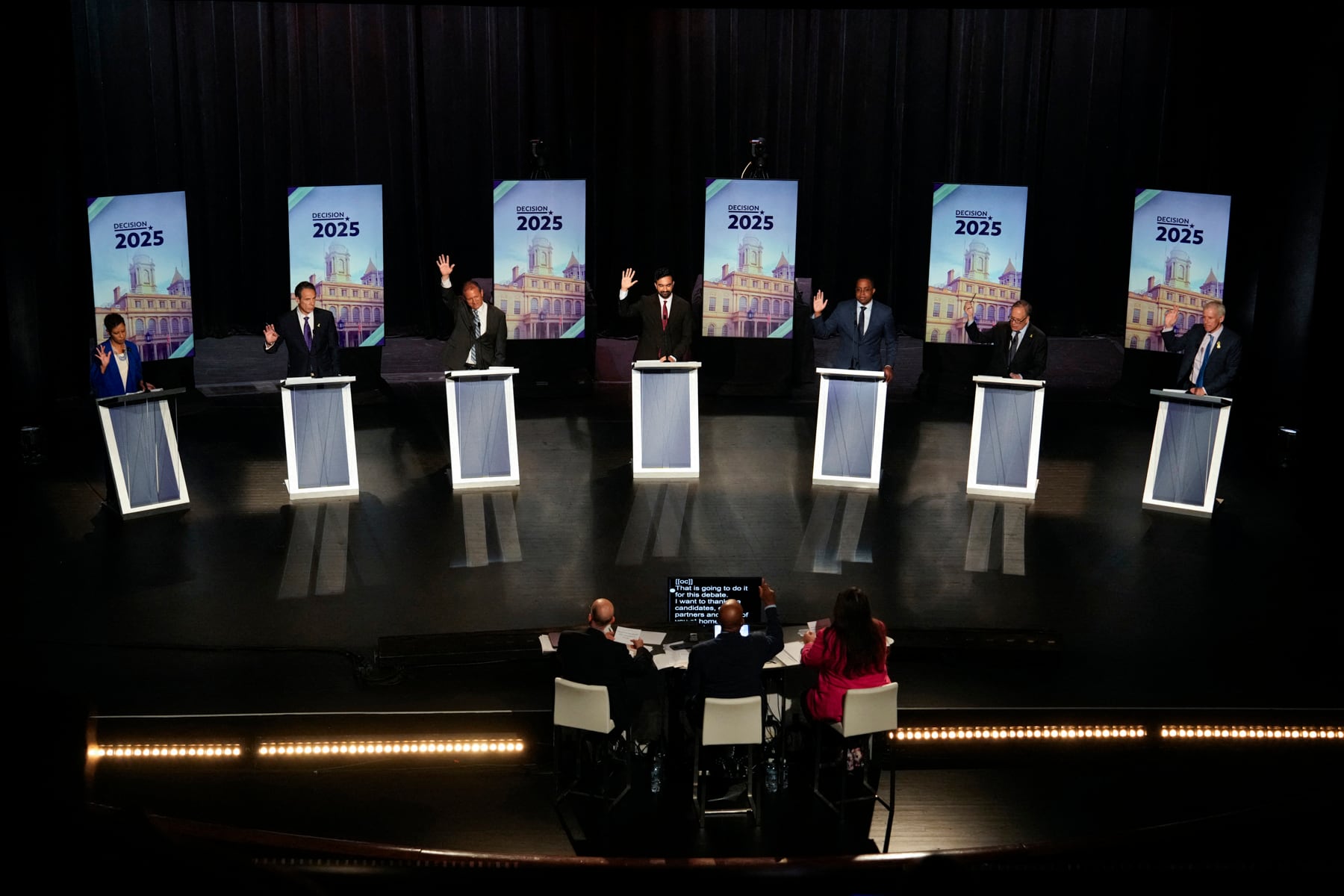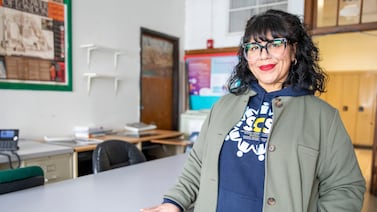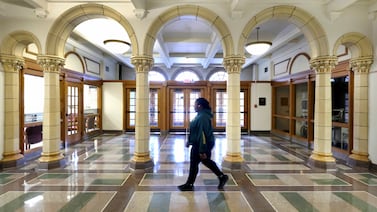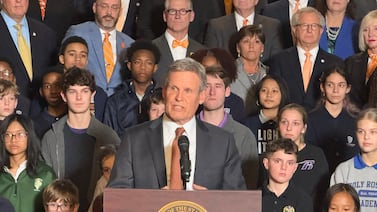Sign up for Chalkbeat New York’s free daily newsletter to get essential news about NYC’s public schools delivered to your inbox.
This is part of a series in which Chalkbeat asked the mayoral candidates questions about important education issues that will likely define the next four years. The primary is June 24, with early voting from June 14-22.
The candidates running for New York City mayor have not made education a central issue, yet operating the nation’s largest school system is one of the top responsibilities for the chief executive of the Big Apple — and it commands the most resources.
The mayor controls the Education Department, appointing a chancellor who oversees its $40 billion budget, roughly 150,000 employees, and 1,600 schools serving nearly 911,000 students.
The next mayor will face entrenched issues — from disparities in student performance to school segregation — that the candidates have largely sidestepped.
They also must address pressing questions about how to implement the state’s class size mandate — an expensive task that will require hiring thousands of new teachers. Meanwhile, they will confront a Trump administration that aims to slash federal funding and root out diversity and equity programs.
Chalkbeat asked the mayoral candidates seven questions about education issues that will likely define the next four years, including whether they would follow through on Mayor Eric Adams’ reading and math curriculum overhauls and whether they would move to close the growing number of tiny schools. (The mayor declined to participate because he is not running in the Democratic primary.)
Here are our main takeaways from their responses. You can read their full answers by clicking on each headline.
Would you continue the current administration’s curriculum mandates for literacy and math?
Eric Adams’ most prominent education initiative is a massive overhaul to reading instruction, requiring schools to use city-approved curriculums. The move is part of a national “science of reading” movement that has drawn attention to flawed approaches to reading instruction many schools have long embraced.
The mayoral candidates generally support the reading curriculum changes, though several said teachers need more support and training. Several also suggested the mandate should be less rigid.
Queens state Rep. Zohran Mamdani wants to “enable more teacher discretion” in how the curriculums are implemented. Echoing concerns from some parent leaders, city Comptroller Brad Lander and former U.S. assistant attorney Jim Walden both want schools with a track record of success to have more leeway to skirt the curriculum changes.
The candidates were much more skeptical of the city’s effort to standardize math curriculums, particularly high Algebra I courses, a change that has drawn pushback from some educators and the teachers union. Former Gov. Andrew Cuomo and Queens state Sen. Jessica Ramos each expressed misgivings about the math changes and Lander said he would “ask my Chancellor for a full review of the data” and consult with educators before making a decision about whether to scrap it.
How would you continue implementing the mandate to reduce class sizes?
Under a 2022 state law, New York City must sharply reduce class sizes. Meeting that mandate will require hiring thousands of additional teachers, creating more classroom space, and finding billions of dollars.
Reducing class sizes is a major priority of the city’s teachers union and nearly all of the candidates said they would comply with the law’s requirements, which mandate that classrooms shrink to 20-25 students depending on the grade level by September 2028.
The mayoral candidates generally agreed that funding is a major hurdle and vowed to press state officials to cough up more money to implement it. Former city Comptroller Scott Stringer and Mamdani said they would also cut waste and repurpose existing funding within the Education Department’s budget to help pay for it, though they did not offer specifics.
Former Bronx state Rep. Michael Blake plans to boost the teacher pipeline with apprenticeships and “grow your own” programs. Lander also indicated that he would prevent schools from shedding teachers if their enrollment declines, a common practice as funding is typically tied to student headcount. The candidates largely did not address a host of difficult tradeoffs, including whether to cap enrollment at popular campuses or which schools should receive exemptions.
Two candidates said the law should be overhauled or scrapped. Walden said it should be revised to focus on high-need schools. (Higher poverty schools already tend to have smaller class sizes, which means the law is likely to benefit more affluent campuses.)
Former hedge-fund executive Whitney Tilson said the law should be rescinded entirely. “The class-size mandate is a costly giveaway to the teachers unions that will do nothing to help kids,” he said.
What’s your take on the city’s selective school admissions as well as the Specialized High School Admissions Test?
New York City’s notoriously complicated high school application process has long created a tiered system with dozens of “selective” schools basing admissions on grades, and the eight specialized high schools using an exam for entry.
Nearly all of the candidates would keep the Specialized High School Admissions Test, or SHSAT, which is enshrined in state law. Several called for expanded test prep access. It’s a sea change from four years ago when several candidates (including Stringer) called for eliminating the exam, which is often blamed for the low numbers of Black and Latino students at these schools.
Several mayoral hopefuls are also calling to increase the number of screened schools.
Blake was the only candidate calling to replace the SHSAT with “multiple measures, such as academic records and lived experience.” Mamdani, a Bronx Science alum and former standardized test tutor, said he’d support an independent analysis of the SHSAT for gender and racial bias. Lander said he’d keep the SHSAT but double the number of specialized high schools, with the new ones accepting the highest performers from middle schools across the city, a move he hopes would “alleviate the pressure families face to invest heavily in test preparation.”
How would you approach school safety and security, as the city has seen the number of school safety agents dramatically drop?
During the last mayoral election, New York City schools were planning to shift the school safety division from NYPD supervision to the Education Department, and several candidates explicitly backed the idea of redirecting financial resources from the Police Department toward mental health and other student support.
The Adams administration reversed course on taking away NYPD’s authority of school safety agents, who are uniformed but unarmed police officers stationed at schools, and public conversation calling for systemic reform of school safety has receded. At the same time, however, the number of school safety agents has shrunk from 5,000 during the 2019-20 school year to 3,600 currently, a drop of roughly 28%. Many principals have concerns about the drop, but some critics of the current system see the declining headcount as an opportunity to rethink school safety.
Many candidates support staffing up the school safety agent force. Lander called for a pay increase for the job that has an annual starting salary of $36,000. He and others also called for expanding mental health support. Several called for bolstering restorative justice approaches to help address conflict resolution. City Council Speaker Adrienne Adams believes that schools should get to decide their own safety approach, providing support for school communities that want more safety agents.
With a growing number of small schools, would you consider ramping up closures or mergers?
Nearly 200 schools enrolled fewer than 200 students last school year, almost double the number from about a decade ago.
And enrollment drops are expected to continue in the coming years.
With funding tied to student headcount, the next mayor will likely have to grapple with the growing number of tiny schools.They’re often costly to run, yet unable to afford a full complement of programs. Several candidates said they would support mergers or closures, with some saying they’d like to ensure community engagement in the process.
Cuomo said it would be “irresponsible” to take mergers and consolidations off the table. Mamdani said he’d consider mergers as well as capping overenrolled schools. Lander, who had issued a report on this as comptroller, favors mergers that intentionally integrate under- and over-utilized schools, through a lengthy community-involved planning process.
Adrienne Adams, however, said school closures are “not an option of particular interest,” and she would create a working group with teachers, parents, students, and city and state education officials to tackle the small schools issue.
What’s your take on mayoral control?
Under mayoral control, which became state law in 2002, New York City’s chief executive has a tremendous amount of authority over the nation’s largest school system.
Supporters of this system say that making one person responsible for the system’s performance ensures a clear line of accountability. Opponents argue that the system is anti-democratic and makes the system vulnerable to political winds with each new administration.
The state legislature will once again consider the fate of mayoral control, when it’s up for renewal in 2026, putting the onus on the next mayor to make a case for what the city’s governance model should look like.
Most of the candidates support mayoral control, but several called for greater transparency and including more parent voice.
Lander called for “municipal control,” with centralized management reporting to the mayor, but also space for parents, students, and other local elected officials to weigh in. He would, for example, “seek advice and consent” from the City Council on appointing a chancellor.
Mamdani said he opposed mayoral control “in its current iteration” and would create a more “participatory educational system” with “co-governance” from the Panel for Educational Policy, school leadership teams, and Community Education Councils. Ramos said she would consider bringing together teachers, parents, students, and experts to develop an alternative to mayoral control.
How would you respond to the Trump administration’s threats to revoke federal funding from schools?
Pushing back on the Trump administration has been front and center for many mayoral candidates.
Donald Trump has taken a particular interest in decimating the federal Department of Education, and in his efforts to root out diversity, equity, and inclusion programs from schools, Trump has threatened to withhold federal education funds. (The city gets roughly $2 billion a year in federal funding.)
Several of the candidates vowed to continue challenging the legality of Trump’s moves to withhold congressionally authorized funding. Brooklyn state Sen. Zellnor Myrie, for example, said he’d consider using the city’s financial contributions to the federal government as leverage: “New York must explore a nuclear option of withholding any state or local remittances to the federal government if Trump ignores a court order to give our city its funds.”
Cuomo said he would fight on behalf of the school system and that he had the most experience in standing up to Trump, but he also took a more conciliatory tone, saying, “I will work with the Trump administration to get the best possible treatment for the New York City school system and its students.”
Mamdani, meanwhile, claimed that Trump would have leverage with Cuomo, who he says “is backed by Trump’s donors.”
Amy Zimmer is the bureau chief for Chalkbeat New York. Contact Amy at azimmer@chalkbeat.org.
Alex Zimmerman is a reporter for Chalkbeat New York, covering NYC public schools. Contact Alex atazimmerman@chalkbeat.org.






